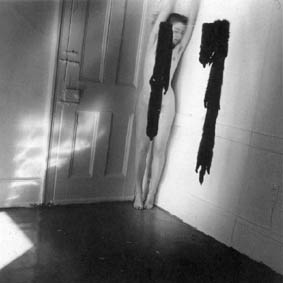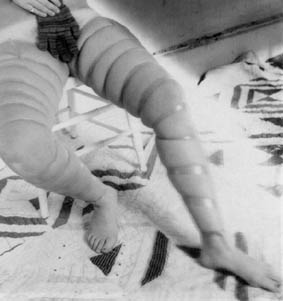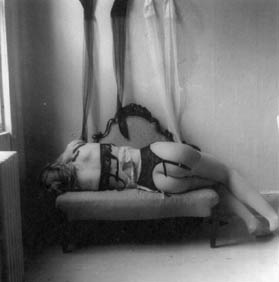It's difficult at times to find the proper words to describe certain works. You just want to slip the images right under the viewer's nose, feeling certain he will understand and share the feeling that, yes, nothing need be said. It's also demands a great effort to evaluate as photographs, pictures that look like rehearsals, the act of practicing in preparation for being an angel.  The photographs that Francesca Woodman took between 1975 and 1981 belong to this category. They cause the same kind of confusion that's so common when we speak about love: the ambiguity only increases with the strength of the feelings involved. In these pictures ambiguity reigns sovereign, fruit of the artist's respect for her inner world and her curiosity concerning a fragmentary but strong-felt reality.  Now that some years have passed, it's strange to consider that at a time when photography and art shared the same interest in what we called "de-constructionism" Woodman preferred to construct her scenes by superimposing various levels of the real rather than breaking down reality to study the image's constructive mechanisms. In a similar way, at the end of the 70s Cindy Sherman appeared on the scene with a series of photographic "Film Stills" that manifest the influences of the film culture and a linear approach to the image. Each picture was a "slice of life," walking the line between fiction and reality. Each picture provided the viewer with a precise image of a woman acting out our cliches concerning traditional female roles. But in spite of the common ground shared by these two photographers, Woodman never seemed interested in the cultural model of today's woman: there is no objective investigation in her work, only a personal kind of research. Basically, while Cindy Sherman offered — in image after image — a fragmentary vision of women, Francesca Woodman gave us a cumulative one, images that take on the woman's different models.  The influence of surrealism must also be considered for its interpretations of the female body, which represented a break with traditional models of representation. But even in this case, it would be risky to look for influences which, in the long run, might not hold much water. If surrealism sublimated the chance events, Woodman's photographs seem to be a complex of combinations, a space for the transitory, for change, but her work has little or nothing to do with the idea of improvisation.  Woodman was photographer and model, subject and object, at the same time. She utilized the female body to develop her own self-knowledge and not some representative but generic model of the world. The images of the body that this young American was experimenting with suggest a diffuse intimacy while tending to dissuade a voyeuristic approach. Unlike most of the images we are faced with on a daily basis, where the body is treated like a commodity to be used and consumed, or an icon to adore at safe distance, Francesca Woodman employs her body to initiate a dialog with herself. She places her body in familiar settings, though at the limits of our experience, presenting it as a symbol of receptivity, a meeting place between herself and the rest of the world, a communicative model in which information about her experience is presented and reflected upon. She uses her own body as a model to investigate her own vision and not another's vision of her body. Woodman projects images and symbols, hopes and fears onto the female body. She uses it like a gesticulative vector not fully known to her, communicating to the viewer the novelty of her encounter.  On the one hand, this attitude was motivated by the artist' s own youth, since these pictures were taken when Woodman was in her late teens and early twenties, in the years before she committed suicide. Art critic Kathryn Hixon wrote in her essay "Essential Magic" (Zurich, 1992): "Woodman's pictures are not de-constructive, but constructive. She added layers of reflection and mimicry within the photograph to confound the transparent recording of the real. The images become psychological portraits of the identity of the body, rather than identifying physical portraits that reveal the psyche." To mention the psychological component is very important in the analysis of Woodman's oeuvre. The symbolic reconstruction of reality, without doubt, can be considered as a mechanism in the recognition/awareness of reality itself. It's as though the artist were researching into the formation of her own personality by exhibiting— sometimes even in the photographs themselves — her impulses, reflections, vulnerability, her awareness of the moment, and the horror of sudden absence. Many of her pictures seem to go in this direction, from the early images taken in Providence, to the "Angel"; series and the portrait multiples, in which three women were portrayed with a picture of Woodman's face covering their own (an homage to Meatyard?). These are psychological portraits: not the visual records of daily existence but episodes in which the expressive capability of the artist's imagination is intertwined with the richness and intimacy of her own life. Yes, we know, it takes a great effort to become an angel, and yet her pictures are still fluttering somewhere around our minds. Gianni Romano - Milano Oct.1998  |